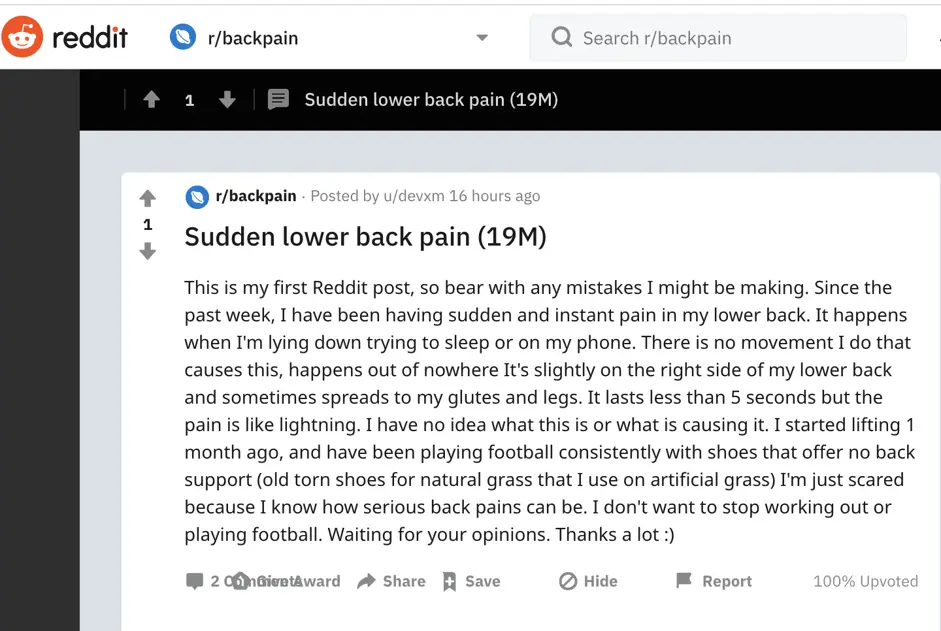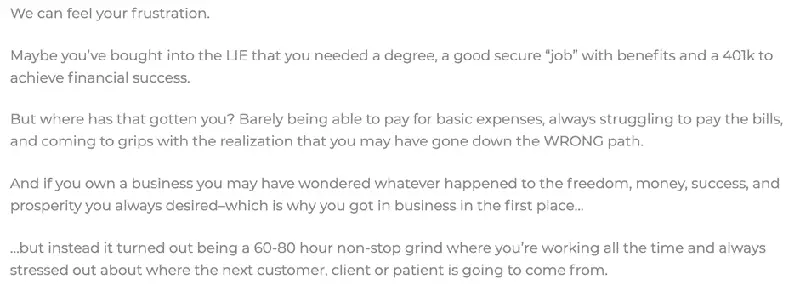
If your marketing is a house then copywriting is the foundation. The reason for that is that it has a place in all parts of your marketing. In everything from Facebook ads, your landing page, you are about you page, your blog posts, etc.
Yet few are actually mastering it, which is a huge opportunity for you.
So if you want to improve your:
Then let’s start with the first step now.
Research is by far the most important part when it comes to copywriting. A common misconception is that a copywriter makes up something from nothing. That can’t be further from the truth. A good copywriter is obsessed with the customers and is using their own words to make them take action.
If your offer sucks and nobody wants your product, then, unfortunately, there is not so much you can do. Copywriters don’t create needs, they find the need. By having that out of the way let’s start with the questions you have to ask yourself when writing copy.
This is the most fundamental thing that you need to begin with. Without being 100% clear about who you want help, you’ll talk to everybody. And a common saying in copywriting is that:
“He who talk everyone talks to no one”.
By targeting a specific group you’ll be able to be way more relatable.
This is why it’s crucial that you are narrowing it down.
For example:
As a psychologist, I like to help financially successful men who are between 50-65 who are experiencing a lot of stress and have poor contact with their emotions.
In this part, it is important that you’re clear about what it is. This is about the benefit the person is going to get out of the product or service you’re providing.
For example:
I’m helping them to be more in touch with their emotions and to be better at managing their stress.
Here’s where your secret sauce is. In copywriting this is called the features.
For example:
I’m starting with finding out the root of your problem. Then we’re creating a plan on what we can do to make you feel less stressed and spend more time on things you actually enjoy working with.
This is a very important part to be able to build trust with the customer. Another reason is also to be able to create empathy which is one of the most crucial things when it comes to copywriting.
This may be that someone you know has had this problem and you’ve seen how bad it really affects them.
For example: The reason why I care about this problem is that I had a brother who was very successful but felt so bad that he hanged himself. (It doesn’t have to be as dramatic as this example)
This is where you’re addressing why you are unique and why you are the best option. It doesn’t mean that you shall trash-talk your competition. It just means that you shall know what differentiates you from them. The last question about why you care about your customer’s problem will help you with this. The reason is that it will make you able to relate to your customers on a deeper level.
Another thing that will help you is to add your personality to what you’re offering. This will put some customers off but on the whole, it will make you stand out. And the customers you’re putting off will not be your ideal customers anyway.
For example: I don’t believe in sugar-coating things, I believe in telling you the hard truth whether it’ll make you comfortable or not.
The last and the most common thing people are using when trying to differentiate themself from their competitors is their credentials. This one is often a bit overused. If you’re only bragging about all your credentials in your copy it will be very likely to turn your prospects off. Instead, it is a better way to only use the ones who would be the most relevant to your customers.
For example: In the last 10 years I have really seen what a big difference this can make for the 1000s of people I’ve helped.
The hidden competitor and often the one that’s causing you to lose the most amount of sales. The hidden competitor is to just do nothing. Although this is one of the most common causes of lost sales, very few businesses are actually doing anything about it. This is a big opportunity for you, so this is how you can leverage it:
It’s easy: Make the cost of not taking action seem way higher than the risks and costs of taking action.
Now, we are at the single part that will be the most time-consuming but also the one that’s the most important for you to write a great copy. As I said before “great copy does not come from you but from your customers”. This is how you create a copy in your customer’s own voice.
This technique will allow you to:
It’s very easy, everything you need to do is to go to a place where they have reviews like Amazon, Udemy (if you’re selling a course), yelp etc.
Then look at the popular products in your space and look at the 5-star reviews to see what the persons who really loved their products said about it.


Write a list of both the most frequent phrases people are using but also the ones that are the most vivid.
Then do the exact same thing with the 2 and 3-star reviews. Here you will see which parts the customers weren’t satisfied with and where you can fill in that gap.



Go to forums like Reddit or ones for your industry and search for keywords related to what you’re offering. By doing that you will get a good understanding of what problems people are facing and most importantly which words they are using to describe them.

Dive deep and exactly as with the last one write down the most vivid and frequent phrases they use to describe their problem.
If you’re about to help people with back pain then go to the backpain subreddit and look at threads like this one.
In social media mining, complaints are the main thing that you’re trying to find. The way you do that is by searching for a keyword on for example Facebook, Twitter etc. Then, do exactly as with the last ones and look for the most common and vivid phrases.
With social media mining, you will also be able to see the demographics of the people who have the problem. This will make you able to adjust your overall message in a better way.

Of all the ways to study the customer, this one is by far the best one. By doing this will you be able to see what exact language they are using and you’ll also be able to find the objections that they have.
This one is not always easy to pull off but if you do, it will pay a huge dividend. One thing you can do to increase the likelihood of the customer to say yes to an interview is to offer something like an Amazon gift card.
Quick note: When you’re answering these questions imagine that you’re taking a beer with the character. This will create a relaxed vibe you want to use in your copy.
Ask these questions:
When you’ve asked these questions, create a document where you’re gathering all this information together. You can also add a picture to make it even more vivid.
Know we’re going to get into some of the best formulas to get your buyer from reading your headline to taking action.
This is one of the easiest formulas that you’ll be able to put to use whenever you’re done with reading this article. Yet it is one of the most effective ones ever. The formula was popularized by the legendary copywriter Dan Kennedy who’s written the book The Ultimate Sales letter which has become an all-time classic.
The first thing you need to do is to address the problem the customer has. This can, for example, be weight problems, work problems, financial problems, they don’t have enough time etc.
This problem you will have gathered when you studied the target customer. Remember to use the customer’s own language at this part. You’ll not be better at describing their problem better than themself.
Example:

In the last stage, you reminded your customers about the problem they’re facing. Now the next step is to really make them be concerned about it. The way you do it is by telling them that nothing will get better if you aren’t doing anything about it.
That’s something a lot of people aren’t thinking about because it’s uncomfortable, but it’s true (in many cases). Often it will just get even worse if they aren’t doing anything. Paint the picture of what their life will look like 5 years from now if they aren’t doing anything to solve their problem.
Now when you’ve created the feeling that they need to take care of this problem we will come to the most important step. That is to ride in like a knight on a white horse and save the day. The way you’re doing it is by presenting the solution, which is your product or service.
Many people are against this formula because they’re believing that this a way of exploiting people’s pains and it is…
If you’re doing it the unethical way. That is to either make up a nonexisting problem that you can solve for a buck or to not deliver on what you promise.
Going too hard with this formula will not work either on all audiences. A way to see how the customer reacts to it without risking your relationship with them is to show some customers the sales page before everybody else.
If they say it’s good, it means it’s bad. If they really like it, they will vote with their wallets.
This is by far the most popular copywriting formula, this how it works!
To capture attention is the first part of the formula. This is the headline of your copy. A common mistake many copywriters make in this part is that they think they have to sell here.
This is not the case. The only job the first sentence has is to make the reader read the second one. In the same way, is the second sentence job is to make them read the third one, etc
Here are some tips to grab attention in your headline:
“Did you know that your family name was recorded with an ancient coat of arms more than seven centuries ago?”
In the first 100-300 words is often where you’re focusing the most on the interesting part. So what can you do to be better at creating interest?
This formula stands for:
Example: Today I’m going to show how I lost 30 pounds in 4 months.
“ Picture of me 4 months ago” “Picture of me now”
If you want to do the same keep reading.
Another great way to capture attention is to paint a picture of the customer and where he will be after they’ve bought your product.
Example: Picture looking yourself in the mirror you can barely recognize yourself…
Stories are great for making people engaged. Studies have shown that we’re way more likely to resonate with something told in story form.
Here’s a guide on how to tell great stories for copywriting.
Now you’re going to make the reader really desire your product or service. The way you do that is by conveying human needs.
The needs are:
Not everybody has an urge for every one of these. That’s why an important part of knowing your customers is which drivers they’re driven by.
This is the call-to-action and the most simple part of the formula. Don’t make it clever or funny just make it super clear.
Example: Click here to start your free trial now.
Which recommendation would you trust the most the one from a salesperson or one from a friend?
If you’re like most people you would have a little bit higher level of trust for a friend than for a salesperson(If not, then you need new friends). The reason for that is that testimonials are made in an unbiased voice unlike to you who will profit on the sale. Meanwhile are people also way more likely to see the value from a product if someone is describing exactly how it has helped them.
When it comes to testimonials is it better how more personal they’re made. With other words:
The worst testimonials are just quotes without even a name on. How shall you trust that this one is true?
A better one is with a name and a picture of the person who benefitted from it.
If you can be able to get video testimonials, do it they’re the best ones you can have.
A mistake that’s costing many businesses sales is that they aren’t addressing the buyer’s objections. They think that by just pretend like they don’t exist, they will go away. That’s unfortunately not the case, in most instances it’s unhandled objections that are costing you the sales.
Some common objections to think about are:

Often is fear keeping people back from buying your product. They want to know what would happen if they aren’t getting satisfied with it.
One thing you can do is using a money-back guarantee. Now, it will not be a risk for the customer if it doesn’t work out.
This is the part that many copywriters are spending the most time on and it seems logical right?
Yeah but great copywriters are only spending around 5% of their time on the writing part.
The other 95% is spent on research and editing. This is why this is going to be a short section.
When you’re writing the copy it is always best to have it in a conversational tone. That’s why you need to write it like you’re asking questions and answering them to the character you created back when you did research.
When you’re writing just write it down and let nothing interact with the flow. It’s no problem if you get some typos you will correct any errors in the editing part.
Now you’ve written your copy and are on the final part. This where you’ll get a true advantage over your competition. The reason for that is that very few actually know how to do copy editing. So by just following the tips here will you beat 95 percent of all copywriters!
It doesn’t matter how persuasive your copy is if people aren’t reading it. And people will not just head over to your page and read everything. The first thing most people are doing is to look to decide if they’re going to read. The best thing you can do in this situation is to break up the text into smaller paragraphs.
A good rule of thumb is to never have a paragraph longer than 5 lines.
Another thing that will help people with deciding whether they are going to read your copy or not is to add subheadings. By doing it you will make the reader see what the different sections are about.
In addition, it also provides eye relief.
If you really want to create great subheadings to these 2 things:
People will always look for a spot where they can stop reading and go doing something else. Your job is to never give them that spot and the way to this by structuring your paragraphs into three types.
This is where you’re giving your prospect some kind of really interesting information that’s just making them say WOW. The reason why this will make them keep reading is simple:
“When they’re are reading something interesting they will want more.
The look on Suzy’s face was like someone just died, I could never imagine that she would take it so bad.”
See what I did there?
I made a cliffhanger by leaving out an important part of the information you provoke a question. It will make most people keep reading because they want to know what I did to Suzy.
Another way to use cliffhangers is like this:
“But this isn’t the worst part.”
By doing that will you leave the reader wondering what the worst part is.
I couldn’t even imagine what happened yesterday…
With an incomplete sentence, you’re doing the exact same thing as with a cliffhanger but you’re leaving it obviously incomplete, unlike the cliffhanger.
When I used to write in school I almost wrote one-page sentences. The reason for that was that I didn’t get grades of how I wrote but of what I wrote. In copywriting it’s not the case. If you aren’t making your copy easy to read by having short sentences nobody will stick to it.
That was something I got to learn the hard way. But you don’t have to, a great tool you can use to break your too-long sentences up into shorter ones is Hemingway.
By reading your copy aloud will you be way more likely to find both grammar errors and places where you’re sounding a bit off. It will be a bit uncomfortable in the beginning but it will be worth it!
Besides subheadings are also bullet points a great way to suck in undecided readers. When it comes to writing sales copy one of the best things you shall list are benefits and/or features. It will both give your reader a clear understanding of what they will get but will also provide eye relief.
Often when we write we’re doing it by referring to the past. By making your copy be in the now you will increase the urgency from the buyer side. Instead of writing:
Dr. Smith has helped many athletes to improve their performance.
Write like this:
Dr. Smith is helping many athletes to improve their performance.
You see what I did there?
I just looked for verbs ending with “ed” and then changed them to ending with “ing”, then I adjusted the sentence to it.
Powerwords are words that create a strong feeling for your reader. And one thing I can promise you is that without the reader feeling an emotion he will not buy.
Some examples of powerwords are to write “crisis” instead of “problem” or to write “skyrocket” instead of “increase”.
In most copywriting courses will you get a list of powerwords to use but I will not provide it. The reason is that it’s going to sound off when you’re using words which aren’t your own and the readers will feel it.
A better way is to look at radaronline every day for a week and make 2 lists. One for negative words like “disturbing” and “horrific”. Then make one with positive ones like “jackpot” and “greatest”.
After you’ve added power words is it time for the so-called “that hunt”. The thing you’re doing here’s to remove all unnecessary that’s in your text or change them to “which” or “it”. By doing this simple exercise will you see that your copy will flow way better.
To do this exercise more effectively: Press the buttons (cmd + F) on mac or (control + F) on a PC. Then type “that” and you’ll save your self a lot of headaches trying to find every single “that” in the text by yourself.
Back in school, you would often get rewarded to change easier words to more complicated ones. Meanwhile in copywriting this couldn’t be further from the case. Here’s everything about making your text smooth and easy to read. When simplifying your text is also a spot where the Hemingway app certainly will help.
The thing it does is to highlight all the words you can change to easier alternatives. Then it also comes with suggestions. Besides that grades it also you’re writing from 0 to 12 depending on the difficulty to read. I would urge you to at least be at a 9th-grade level or below.
A common tip copywriting experts give is to change the I to you to be more centric on the reader. That tip is good but here’s a more pro version of it that’s used by only the best ones:
Make “I” take on all the negative and make “you” take on all the positive. By doing this will you decrease the reader’s skepticism in a huge way. The reason is that copywriters often tries to paint a picture of someone’s situation.
But it’s impossible to make it 100% accurate and when it’s off it will create skepticism from the reader’s side. When you’re taking on all negative it does feel a less try-hard. Meanwhile, it will also make your reader be way more likely to relate to the story.
P.S You don’t need to do all these things one by one, you can do many of them in a few sweeps.
You may also like: Intelligent Marketing for Business Success
Image source: Shutterstock.com

Generating leads is a crucial...

Welcome to the Future of...

It is evident that social...